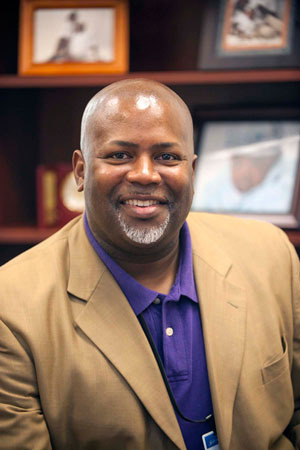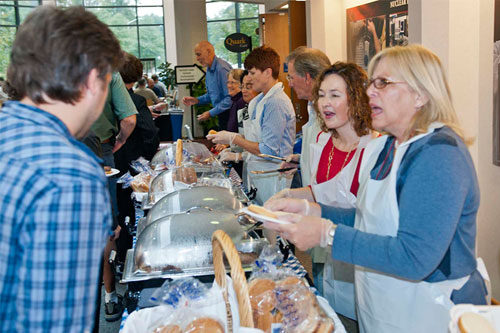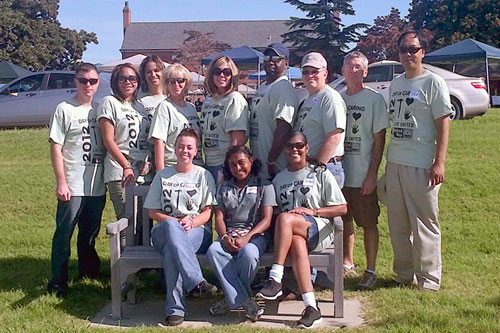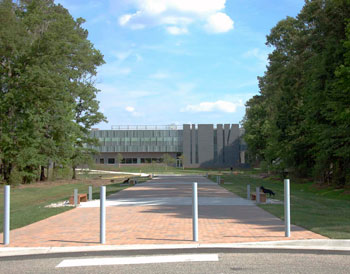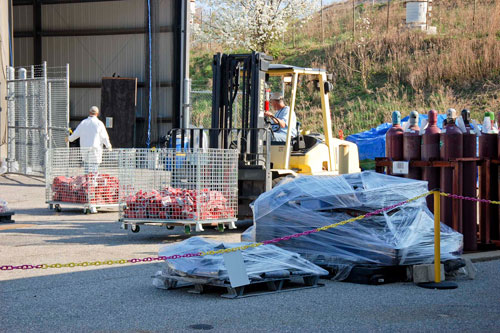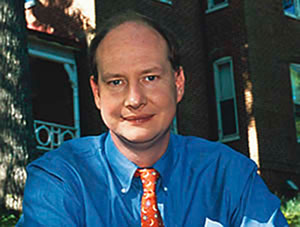
|
October 2012
|
|
|
The U.S. Department of Energy's Thomas Jefferson National Accelerator Facility
|
|
Science Ed. Team Receives DOE Achievement Award |
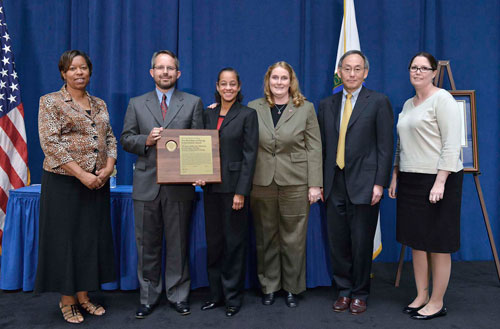 Jefferson Lab's Science Education group was recognized recently with a 2012 Department of Energy Secretary's Honor Award. The group received the award from Secretary Steven Chu at DOE Headquarters. Pictured with the award and Secretary Chu are Science Education team members (left to right) Telesha Brown, Steve Gagnon, Lisa Surles-Law, Education Manager Jan Tyler, and Christine Wheeler. Unavailable for the photo: Brita Hampton.
Jefferson Lab's Science Education group was recognized among the best in the U.S. Department of Energy during a ceremony at DOE Headquarters in Washington, D.C., on Oct. 4. The group earned a 2012 Department of Energy Secretary's Honor Award, which recognizes individual and team excellence and achievement. It is the highest non-monetary award presented by the secretary of Energy. The individuals and teams receiving the awards are selected and presented their awards by Secretary Steven Chu. Jan Tyler, Science Education manager, and staff members Telesha Brown, Brita Hampton, Steve Gagnon, Lisa Surles-Law and Christine Wheeler were one of the 11 groups to earn the Secretary Achievement Award....... more |
|
|
Deputy AD for Physics Kindles Passion for Life, Physics
|
Procurement Manager Brings Decades of Experience to Lab
|
Lab Community Participates in United Way Programs
|
||
|
|
||||
Below the Fold:
|
||||
Science Ed. Team Receives DOE Achievement Award |
|
Jefferson Lab's Science Education group was recognized among the best in the U.S. Department of Energy during a ceremony at DOE Headquarters in Washington, D.C., on Oct. 4. The group earned a 2012 Department of Energy Secretary's Honor Award, which recognizes individual and team excellence and achievement. It is the highest non-monetary award presented by the secretary of Energy. The individuals and teams receiving the awards are selected and presented their awards by Secretary Steven Chu. Jan Tyler, Science Education manager, and staff members Telesha Brown, Brita Hampton, Steve Gagnon, Lisa Surles-Law and Christine Wheeler were one of the 11 groups to earn the Secretary Achievement Award. According to the DOE, the Achievement Award is bestowed upon a group or team of DOE employees and/or contractors who together accomplished significant achievements on behalf of the department, and demonstrated cooperation and teamwork in attaining their goals. The Science Education team was commended for "developing and implementing model programs that improve the quality of science education," according to the award citation. The recognition centered on two of the Science Education group's programs: Becoming Enthusiastic About Math and Science (BEAMS) and JLab Science Activities for Teachers (JSAT). 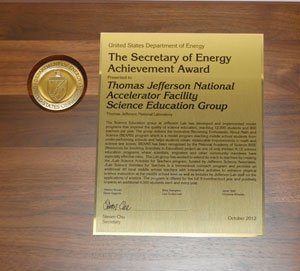 BEAMS is an innovative, long-running program that reaches out to middle-school students from under-performing schools and helps students make measurable improvements in math and science test scores. BEAMS has been recognized by the National Academy of Science RISE (Resources for Involving Scientists in Education) project as one of only 13 K-12 science education programs across the country where scientists, engineers and other community members have especially effective roles. BEAMS was created at Jefferson Lab 21 years ago. BEAMS supports Newport News inner-city public school students as they progress from fifth through eighth grade. With guidance and assistance from lab volunteers and Science Ed. staff, BEAMS students conduct a variety of hands-on experiments and activities. "This program is designed to engage children in the areas of math, science, engineering and technology as part of their education and how knowledge and advancements in these fields impacts the world and society. They also gain awareness of future career opportunities that use STEM knowledge and skills," Tyler explained. "It is always exciting to have students come to the lab and experience some new aspect of science. The program engages the students, and lets them see and experience – first hand – how math and science is used in the real world." "And the reason this program has been such an ongoing success is because of the great support we get from the lab community," Tyler continued. "We couldn't do this program without the steady, upbeat, engaged volunteers who regularly lead or help with classroom activities and role model visits. It is this direct interaction with scientists, engineers, technologists and administrators that really impresses and excites the students." The education group has also worked to extend Jefferson Lab's impact in the community by developing the JLab Science Activities for Teachers program, which is designed to annually empower 60 elementary- and middle-school teachers of science by increasing their knowledge of the physical sciences and by strengthening their teaching skills. JSAT, partly funded by the JSA Initiatives Fund, provides attendees with a wealth of information, materials and activities to take back to their classrooms. It also offers participants the opportunity to network with other teachers and share valuable teaching experiences. The Virginia Mathematics and Science Coalition, an alliance of education, corporate, and public policy leaders working together to revitalize mathematics and science education in prekindergarten through graduate school, recognized JSAT in 2011 with a Programs That Work Award. According to the VMSC web site, the awards "recognize exemplary mathematics and science programs for which there is evidence of a positive impact on student or teacher learning." "It's one thing to inspire individual students, but this program is gratifying on a much larger level," Tyler noted after receiving the DOE award. "When we can help teachers become more knowledgeable and be more engaging in the classroom, and also give them tools to make class time more productive, JLab is ultimately having an enormous impact on a larger number of students over many years." "We are very grateful to our many volunteers; we couldn't run these programs without their time, effort and insight," Tyler said. "We thank JSA and the lab leadership and staff for supporting these valuable science education programs, and we are very appreciative to DOE for recognizing their importance and the teamwork required to make them successful." Related inks: |
Deputy AD for Physics Kindles Passion for Life, Physics |
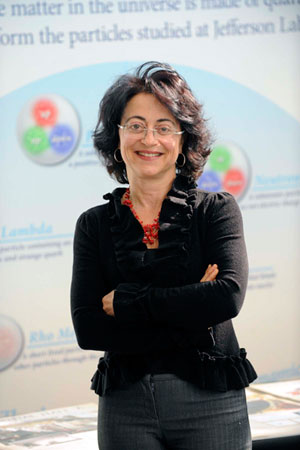 Patrizia Rossi
Deputy Associate Director for Nuclear Physics Talking with Patrizia Rossi, Jefferson Lab's new deputy associate director for nuclear physics, is as much a discussion about life philosophy as it is about physics. Although she had been a Hall B user/CLAS collaborator at the lab since 1993, her new position has afforded her the opportunity to become a much more involved member of the lab community, something that she is embracing with her characteristic passion. "I believe that it is important to start from each instant in your life, to accept every challenge that life presents to you," Rossi notes. Although she started her education believing she would pursue a career in humanities and literature – studying French, Italian and English literature – one of her high school teachers inspired a passion in her for math and physics. Logic and culture suddenly did not seem to be mutually exclusive. She excelled at the University of Rome, studying under the late Nicola Cabibbo, who is known for his work on the weak interaction in quarks. Rossi aced the course and knew she was on the correct trajectory for her life's work. She received a degree in physics from the University of Rome in 1986, before accepting a fellowship with the Insituto Nazionale di Fisica Nucleare (INFN) in 1988 to conduct research and then joined the Laboratori Nazionali di Frascati of INFN as a staff researcher in 1990. Her research has focused on studying the structure of the nucleon and the strong force, areas of major emphasis at Jefferson Lab. In addition to Jefferson Lab and laboratories in Italy, Rossi also has conducted experiments at DESY Laboratory in Hamburg, Germany and the European Synchrotron Radiation Facility (ESRF) in Grenoble, France. From 1996 to 1998, she lived in Newport News with her daughter, Paola, and her husband, while she worked in Hall B. At the end of that time, she decided it was the opportune moment to indulge her other passion – travel. The family took to their 39-foot sailboat and spent a year going down the East Coast of the United States and then on to Central and South America, going through the Panama Canal and down into Ecuador. At the end of their year, which Rossi describes as "fantastic," she returned to physics. Her husband, formerly a physicist at CERN, decided to continue traveling and lives aboard their boat in the Caribbean. Although neither of her parents were scientists – her mother stayed at home and her father had a small business – she credits them with instilling in her a particular philosophy of life that she carries to this day. "These values are my life motif," she says with great passion. "There is honesty to one's self. When you make a commitment, you go all the way to the end of it. And you must always be a trustable person. These are roots of my personality." "My interests are big," she continues. "I must read every night. Right now I am reading Hermann Hesse. I've found a racing group to sail with here, and I love the outdoors, especially hiking. I don't eat out in restaurants that much, because I love to have friends over and cook for them." She's even found a place in Port Warwick to continue the tango lessons that she started when she lived in Rome, where she and Paola, who's now a university student studying anthropology, zoomed through the streets on their scooters. As part of her contractual agreement, Rossi maintains her position as a senior staff scientist at Laboratori Nazionali di Frascati of Istituto Nazionale di Fisica Nucleare (LNF-INFN), and has kept her 70-year-old home in the hills outside Rome, which she's quick to note is in the same neighborhood as the Pope's summer home. Although she contends that she's not "a shopping person," she admits with a laugh that she owns 110 purses. She doesn't have a favorite designer, and says, "I just buy whatever looks beautiful!" Although she has been at Jefferson Lab before, this time is different. "Now I am meeting people from all the halls and major areas, and I am interacting with technicians and engineers as well," she explains. "People have all been very nice. They're very willing to help, from the administrative assistants to the technicians…everyone. They have all said 'Welcome,' not just with words, but with actions. All of these new experiences are dynamic processes and they are fascinating. "There is learning to be done for me here," she adds. "I am very excited about the opportunity. This is an exciting time to join Jefferson Lab as it grows and becomes an ever more interesting place to do research. The 12 GeV Upgrade is a reality and provides a challenge to develop new ideas and proposals to the science program. I am looking forward to being part of this dynamic effort. Being static horrifies me. The biggest challenge in life is to find balance." By Judi Tull |
Jefferson Lab Sustainability Efforts in Action:
|
|
The On Target newsletter is published monthly by the Thomas Jefferson National Accelerator Facility (Jefferson Lab), a nuclear physics research laboratory in Newport News, Virginia, operated by Jefferson Science Associates, LLC, for the U.S. Department of Energy's Office of Science. Possible news items and ideas for future stories may be emailed to jlabinfo@jlab.org, or sent to the Jefferson Lab Public Affairs Office, Suite 15, 12000 Jefferson Avenue, Newport News, VA 23606
|


 Talking with Patrizia Rossi, Jefferson Lab's new deputy associate director for nuclear physics, is as much a discussion about life philosophy as it is about physics.......
Talking with Patrizia Rossi, Jefferson Lab's new deputy associate director for nuclear physics, is as much a discussion about life philosophy as it is about physics....... Lynn McKnight, Jefferson Lab's new Procurement Department manager, is settling into his new office in the Support Service Center and learning about Jefferson Lab.......
Lynn McKnight, Jefferson Lab's new Procurement Department manager, is settling into his new office in the Support Service Center and learning about Jefferson Lab....... The annual United Way appeal is underway at Jefferson Lab and will run through Wednesday, Oct. 24........
The annual United Way appeal is underway at Jefferson Lab and will run through Wednesday, Oct. 24........